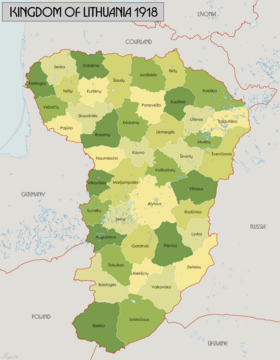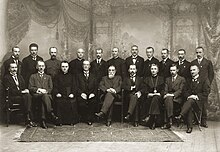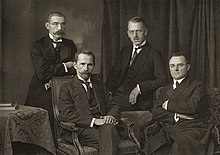Kingdom of Lithuania
|
Kingdom of Lithuania Lietuvos Karalystė (Lithuanian) 1918 |
||||
|---|---|---|---|---|
|
||||
|
||||
| Official language | Lithuanian | |||
| Capital | Vilnius | |||
| Form of government | kingdom | |||
| Government system | Constitutional monarchy | |||
| Head of state | King Mindaugas II | |||
| houses of Parliament | Lietuvos Taryba | |||
| founding |
July 11, 1918 election of the king |
|||
| resolution |
November 2, 1918 Establishment of the Republic of Lithuania |
|||
| National anthem |
Tautiška giesmė |
|||
| Time zone | UTC +2 | |||
| currency | German East Mark and German East Ruble | |||
| map | ||||

|
||||
The Kingdom of Lithuania ( Lithuanian Lietuvos Karalystė ) was a short-lived constitutional monarchy that was established at the end of the First World War on the territory of the German Empire occupied Lithuania . The Lithuanian State Council declared Lithuania's independence on February 16, 1918, but was unable to form a government, a functioning police or other state organs due to the continued presence of German troops. On the German side, considerations were made that would include the incorporation of Lithuania as part of Prussia into the German Empire. The Lithuanian State Council and other nationally minded Lithuanians opposed this idea and hoped to preserve Lithuania's independence by creating its own constitutional monarchy with a king from a German princely house. On June 4, 1918, the Presidium of the State Council voted to offer the Lithuanian crown to the German nobleman Wilhelm Karl von Urach . Duke Wilhelm accepted the election in July 1918 and gave himself the name Mindaugas II , based on Mindaugas I , who is considered the first king of Lithuania. His election sparked controversy, divided the council and did not produce the desired results. Duke Wilhelm never visited Lithuania in his brief formal reign. Shortly before the war and before the November Revolution of the Lithuanian State Council revoked on Nov. 2, 1918 its decision to invite Duke Wilhelm, thus ending his short reign, the already de facto had existed only on paper.
prehistory
After the third partition of Poland-Lithuania in 1795, Lithuania belonged to the Russian Empire . During the First World War, the German Empire conquered the western regions of Russia, including Lithuania. After the Russian Revolution of 1917, Germany conceived the geopolitical strategy for Central Europe , a regional network of satellite states that would serve as a buffer zone . The Germans allowed the Vilnius Conference to be organized in the hope that the Lithuanian people would break away from Russia and establish "close ties" with Germany. In September 1917, the conference elected a 22-member Lithuanian council and gave it the power to negotiate with the Germans over the independence of Lithuania. The Germans were prepared for the coming negotiations on the Brest-Litovsk peace treaty and were waiting for a declaration from the Lithuanians that they want a “firm and lasting alliance” with Germany. Such a declaration was adopted by the Council of Lithuania on December 11, 1917. However, these concessions divided the council and still did not receive recognition from Germany. Therefore, on February 16, 1918, the Council adopted the Lithuanian Declaration of Independence. The council renounced any mention of alliances with Germany and declared the "termination of all state relations that this state previously had with other nations". On March 3, 1918, the German Reich and the Russian Federative Socialist Soviet Republic signed the Brest-Litovsk Peace Treaty, in which the Baltic States were declared a German area of interest and Russia waived any claim in this area. On March 23, 1918, Germany formally recognized independent Lithuania on the basis of the December 11 declaration. However, the country was still occupied by German troops, the council still had no real power and was only treated as an advisory council by the Germans.
choice
Candidates

The military command of Ober Ost asked the German Emperor and Prussian King Wilhelm II to "take the grand ducal crown himself". This would have created a personal union between Prussia and Lithuania. An alternative proposal was the election of Wilhelm's youngest son, Prince Joachim of Prussia . These plans to expand the already dominant Protestant Kingdom of Prussia were rejected by the kingdoms of Saxony and Bavaria . Instead, Saxony beat Friedrich Christian of Saxony , the second eldest son of King Friedrich August III. in front. This proposal was based on historical connections between Saxony and Lithuania: Between 1697 and 1763 three kings of Poland-Lithuania came from the House of Wettin . A number of other candidates were also considered. These plans were seen by the Lithuanians as a threat to their independence. This view was confirmed after a meeting of German officials on May 19, where conventions for the “firm and permanent alliance” and severely limited autonomy for the Lithuanians were discussed.
The idea of establishing a constitutional monarchy and inviting a candidate who would work for Lithuania's independence was further developed. On June 4, 1918, the Presidium of the Council of Lithuania voted in confidence to establish a hereditary monarchy and invite Duke Wilhelm Karl von Urach. Duke Wilhelm was proposed by Matthias Erzberger , who had worked with Lithuanians in Switzerland . His candidacy was discussed since March 1918 at the latest. Duke Wilhelm seemed to be the perfect candidate because he was Catholic, was not an heir to the throne of the Kingdom of Württemberg due to his grandfather's morganatic marriage , had no close ties to the Hohenzollerns , and had no ties to Poland . Due to the obstacles set up by the German military, the meeting of the Lithuanian delegation with Duke Wilhelm in Freiburg im Breisgau was delayed until July 1. Duke Wilhelm and his eldest son (as heir to the throne) accepted the offer without any conditions. On July 11th, the majority of the Lithuanian Council (13 for, 5 against and 2 abstentions) voted for the establishment of the monarchy. On August 12, the council sent a formal invitation to Duke Wilhelm to become King Mindaugas II of Lithuania.
conditions
Duke Wilhelm was presented with a twelve-point proposal that resembled the Pacta conventa . The monarch had the power to appoint the ministers, to enact laws by his signature and to introduce legislative initiatives in parliament. Lithuanians could be elected ministers and these ministers had to report to parliament. The king was required by the constitution to protect the independence and territorial integrity of Lithuania, as well as to maintain religious tolerance. He was not allowed to become ruler of another state without the consent of parliament. The Lithuanian language was to be used as the official state and court language, a special provision in order to limit the number of foreigners at the royal court and possibly also to exclude them from the court. The monarch and his family were obliged to reside in Lithuania and not to spend more than two months a year abroad. His children were to be taught and brought up in Lithuania. Basically, the Lithuanians imposed "elective ethnicity". It is reported that Duke Wilhelm began learning the Lithuanian language and studying Lithuanian history and customs; however, he never visited Lithuania.
Some authors have called these terms a constitution, but this is formally incorrect. The Lithuanian lawyer Mykolas Römeris called this an “embryo of a constitution”, these conditions were kept very simple and a temporary framework that would have evolved into a constitution if the monarchy had not been abolished. A project for a complete constitution was later found in German archives, but it was never discussed by the Lithuanian Council and so remained just a draft.
After the election

Sitting: J. Vileišis, dr. J. Šaulys, kun. J. Staugaitis, St. Narutavičius, dr. J. Basanavičius, A. Smetona, can. K. Šaulys, Stp. Kairys, J. Smilgevičius.
Standing: K. Bizauskas, J. Vailokaitis, Donatas Malinauskas, kun. Vl. Mironas, M. Biržiška, kun. A. Petrulis, S. Banaitis, P. Klimas, A. Stulginskis, J. Šernas, Pr. Dovydaitis.
The proposal for the monarchy was controversial and created a rift between right-wing and left-wing members of the Lithuanian Council. The proposal received the greatest support from Antanas Smetona , Jurgis Šaulys and Catholic priests. After the monarchy was accepted, four members of the council resigned in protest: Steponas Kairys , Jonas Vileišis , Mykolas Biržiška and Stanisław Narutowicz (Stanislovas Narutavičius). Petras Klimas also voted against, but did not resign. At the same time, the council accepted six new members: Martynas Yčas, Augustinas Voldemaras, Juozas Purickis, Eliziejus Draugelis, Jurgis Alekna and Stasys Šilingas. The debate about a constitutional monarchy instead of a democratic republic was not new. As early as December 1917, the council voted with 15 to 5 votes that a monarchy would be better suited to Lithuania. Proponents argued that the Lithuanians were not politically ripe for a republic and that the Germans would rather support a monarchy. The opponents argued that the council had no right to rule on such questions of principle; this was the responsibility of the future constituent assembly of Lithuania.
The Germans did not greet the new king. They claimed that they could only recognize an independent Lithuania on the basis of the December 11th agreement, which provided for an alliance with Germany, and that therefore Lithuania does not have the right to unilaterally elect a new monarch. They also protested against the fact that the Lithuanian Council had changed its name to the State Council of Lithuania, shortly before Mindaugas II's consent. The council, in consultation with the Germans, abandoned the use of the new name, but continued to stand as the new king. The Lithuanian press was censored; she was not allowed to publish any news about the new king while the German press unanimously criticized the decision. When Lietuvos aidas , the council's newspaper, refused to print an article denouncing the new king, it was suspended for a month. German-Lithuanian relations remained strained until October 1918. The election continued to damage the reputation of the council, which the Entente powers and the Lithuanian diaspora have already described as a German puppet. The Lithuanians in the West believed that Lithuania should place its hopes for independence on the Entente and not on Germany. This gap widened and weakened the Lithuanian positions.
Democratic Republic

After Germany's defeat in the war became apparent, the Lithuanians were given more freedom of action. On October 20, 1918, the German Chancellor Prince Maximilian von Baden repeated the recognition of independent Lithuania and promised to convert the German military administration into a civilian government, and that the Lithuanians could take over this as soon as they had sufficient opportunities to do so. After receiving this news, the Lithuanian Council convened on October 28th to discuss a provisional constitution and the formation of a government. Since no projects or drafts had been prepared beforehand, it was necessary for the council to decide what several days were planned for. The changed political situation also forced the council to withdraw the election of Mindaugas II. Since Lithuania wanted to be recognized by the Entente, it could not have a German as king. Duke Wilhelm indicated that he was ready to give up the throne. Therefore, on November 2, the council suspended its invitation to Duke Wilhelm, so that the final decision on the future of the country lay with the Constituent Assembly. On the same day, the council adopted the first provisional constitution that spoke neither of a monarchy nor of a republic. The constitution merely organized the provisional government until the Constituent Assembly made a final decision on it. There was no longer any talk of a monarchy in future constitutions.
Other similar states
During the First World War, the German Reich founded several puppet governments on the territory of the former Russian Empire . However, these states were neither fully independent nor sovereign.
- Duchy of Courland and Zemgale (1918)
- Kingdom of Finland
- Regency Kingdom of Poland
- United Baltic Duchy
Individual evidence
- ^ Stanley W. Page: The Formation of the Baltic States . Harvard University Press, 1959, p. 94.
- ^ Lenore Grenoble: Language Policy in the Soviet Union (= Language policy), Volume 3. Kluwer Academic Publishers, Dordrecht 2003, ISBN 1-4020-1298-5 , p. 104.
- ↑ Lina Kulikauskienė: 1917 metų Lietuvos Taryba . In: Gimtoji istorija. Nuo 7 iki 12 klasės ( Lithuanian ). Elektroninės Leidybos namai, Vilnius 2002, ISBN 9986-9216-9-4 .
- ↑ Mindaugas Peleckis and Tomas Baranauskas. Karališkojo kraujo paieškos: Lietuva ir šimto dienų karalius . Accessed June 20, 2007.
- ↑ Karališkojo kraujo paieškos: Lietuva ir šimto dienų karalius ( Lithuanian ) Bernardinai.lt. Retrieved February 10, 2007.
- ↑ Juozas Skirius: Vokietija ir Lietuvos nepriklausomybė . In: Gimtoji istorija. Nuo 7 iki 12 klasės ( Lithuanian ). Elektroninės Leidybos namai, Vilnius 2002, ISBN 9986-9216-9-4 . Archived from the original on February 26, 2008 Info: The archive link was inserted automatically and has not yet been checked. Please check the original and archive link according to the instructions and then remove this notice. (Accessed January 28, 2007).
literature
- Sergej von Cube: A Prince of Württemberg on the throne of Lithuania, 1918. (PDF file; 52 kB). In: Annaberger Annalen. Volume 8, 2000.


